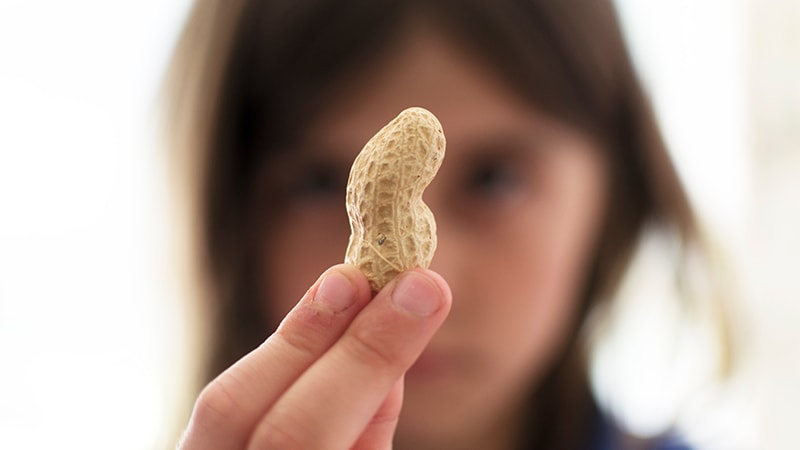Oral immunotherapy (OIT) for food allergy can help prevent anaphylaxis after accidental encounters with an allergen, but the treatment rarely cures the allergy, it has risks, and it requires long-term planning and shared decision-making by patients, their families, and their allergists, according to a new review.
In OIT, a patient who is allergic to a specific food consumes increasing amounts of the allergen over time to reduce their risk for allergic reaction.
“OIT is an elective, usually noncurative procedure with inherent risks that require families to function as amateur medical professionals. Preparing them for this role is essential to protect patients and ensure the long-term success of this life-changing procedure,” lead author Douglas P. Mack, MD, MSc, a pediatric allergy, asthma, and immunology specialist at McMaster University in Hamilton, Canada, and colleagues write in Clinical & Experimental Allergy.
From Strict Avoidance to Desensitization
Food allergy treatment has traditionally involved avoiding accidental exposure that may lead to anaphylaxis and providing rescue medication. In recent years, OIT “has been recommended by several guidelines as a primary option,” Mack and co-authors write. And with the “approval by European and USA regulators of [peanut allergen powder] Palforzia [Aimmune Therapeutics], there are now commercial and non-commercial forms of OIT available for use in several countries.”
They advise physicians to take a proactive, educational, supportive approach to patients and their families throughout the therapy.
“Ultimately, the decision to pursue OIT or continue avoidance strategies remains the responsibility of the family and the patients,” they write. “Some families may not be prepared for the role that they have to play in actively managing their child’s food allergy treatment.”
Strategies to Overcome OIT Challenges
Reviewing the literature about OIT for food allergy, the authors suggest various strategies physicians can use to help OIT patients and their families prepare for and overcome common treatment-related challenges:
| Challenges | Preparation and Solutions |
|---|---|
| Reactions |
Select appropriate patients. Manage asthma and other comorbidities. Understand impact of cofactors and appropriate dose reduction. |
| Adherence |
Provide incentives. Address potential causes of poor adherence. |
| Missed school, sports, work |
Identify specific limitations. Provide flexible clinic schedules. |
| Taste aversion |
Use food-masking strategies. Identify patients with potential predisposing factors. Pre-emptively provide dietitians, child life specialists, or both. |
| Anxiety, fear of reaction, adrenaline, needle |
Discuss reaction risk and patient and parent concerns. Provide psychological support before and during OIT. Train on adrenaline use. Coach on how to self-inject or practice on injecting an expired epinephrine autoinjector into an object. |
| Boredom |
Provide incentives. Providing flexible dosing. |
Two Experts Welcome the Report
Rita Kachru, MD, a specialist in allergy and immunology and a co-director of the food allergy program at UCLA Health in Los Angeles, California, called this “an excellent report about a wonderful, individualized option in food allergy management.

Dr Rita Kachru
“The authors did an excellent job delineating OIT terminology, outlining the goals, risks, and benefits of OIT, noting that it’s not a cure, and emphasizing the crucial importance of discussions with each family throughout the process,” Kachru, who was not involved in developing the report, told Medscape Medical News.
“I thoroughly agree with their assessment,” she added. “The more you do OIT research and clinical care, the more you realize the pitfalls, the benefits, and the importance of patient goals and family dynamics. Discussing the goals, risks, benefits, and alternatives to OIT in detail with the family is crucial so they fully understand the process.”

Dr Basil Kahwash
Basil M. Kahwash, MD, an allergy, pulmonary, and critical care medicine specialist at Vanderbilt University Medical Center in Nashville, Tennessee, said that providers in the immunology community have been discussing OIT for years and that he welcomes the well-written report that summarizes the evidence.
“It’s important to periodically summarize the evidence, as well as the consensus expert opinion about the evidence, so we may better inform our colleagues and patients,” said Kahwash, who was not involved in developing the report. “The authors are well-known experts in our field who have experience with OIT and with reviewing the evidence of food allergy.
“OIT can be a fantastic option for some patients, especially those who are very highly motivated and understand the process from start to finish. But OIT is not the best option for every child, and it’s not much of an option for adults,” he explained. “Patients need to be chosen carefully and understand the level of motivation required to safely follow through with the treatment.
“The report will hopefully affect patient care positively and allow patients to understand the limitations around OIT when they consider their candidacy for it,” he added. “In most cases, OIT patients will still need to avoid the allergen, but if a small amount accidentally gets into their food, they probably won’t have a very severe reaction to it.”
Kahwash would like to see data on patients who have seen long-term remission with OIT.
“Clearly, some patients benefit from OIT. What differentiates patients who benefit from OIT from those who do not?” he asked. “In the future, we need to consider possible biomarkers of patients who are and who aren’t good candidates for OIT.
“Regardless of OIT’s limitations, the potential for desensitization rather than strict avoidance represents a big step in the evolution of food allergy treatment,” Kahwash noted.
No funding details were provided. Mack and three co-authors report financial relationships with Aimmune. Aimmune Therapeutics, Inc. is the manufacturer of Palforzia OIT (AR101 powder provided in capsules and sachets). Most co-authors also report financial relationships with other pharmaceutical companies. The full list can be found with the original article. Kachru was an investigator in the PALISADES clinical trial of AR101. Kahwash reports no relevant financial relationships.
Clin Exp Allergy. Published online September 9, 2022. Abstract
For more news, follow Medscape on Facebook, Twitter, Instagram, YouTube, and LinkedIn
